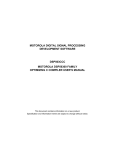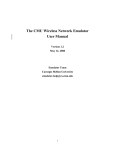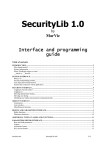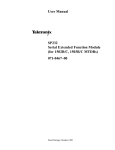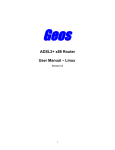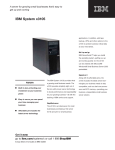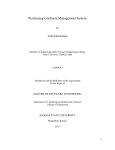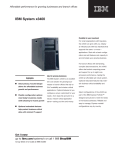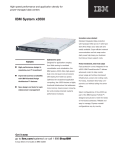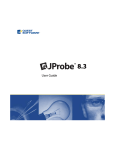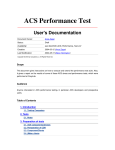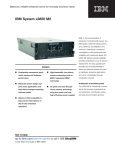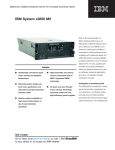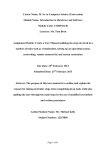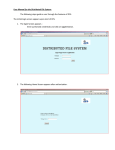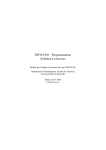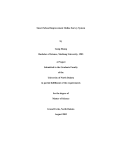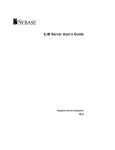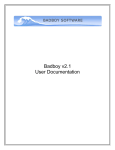Download Evaluation of Web Application Servers
Transcript
Computer Science
Per-Anders Johansson
Magnus Nilsson
Evaluation of Web Application Servers
Bachelor’s Project
2000-10
Evaluation of Web Application Servers
Per-Anders Johansson
Magnus Nilsson
© 2000 The author(s) and Karlstad University
This report is submitted in partial fulfillment of the requirements for the
Bachelor’s degree in Computer Science. All material in this report which is
not my own work has been identified and no material is included for which
a degree has previously been conferred.
Per-Anders Johansson
__________________________________________
Magnus Nilsson
Approved, 2000-05-31
Advisor: Niklas Nikitin
Examiner: Stefan Lindskog
iii
Abstract
A web/application server is used to deliver statically or dynamically built web content to clients on the World Wide Web. This document describes testing of a number of
web/application servers and the criteria with which you can evaluate them. The purpose is to
create guidelines that can be used by Ericsson Infotech to evaluate web/application servers.
iv
Credits
We would like to recognize our appreciation to the following people:
Anders Berg, our instructor at Ericsson Infotech: For everything.
Niklas Nikitin, our supervisor at Karlstad University: For guiding us through this project.
Helena Lindskog: For reading our work and for contributing with good ideas on how to
evolve it.
Mikael Johansson: For reading our work and for contributing with good ideas on how to
evolve it.
Richard Hellberg: Our coach at Ericsson Infotech.
v
Contents
1
Introduction....................................................................................................................... 1
2
Terminology....................................................................................................................... 2
3
Background ....................................................................................................................... 3
4
3.1
History ....................................................................................................................... 3
3.2
Task ........................................................................................................................... 4
3.3
Purpose ...................................................................................................................... 4
Method ............................................................................................................................... 5
4.1
4.2
Choosing the web/application servers ....................................................................... 5
Choosing evaluation criterions .................................................................................. 6
4.2.1
4.2.2
4.2.3
4.2.4
4.2.5
5
Background Information................................................................................................ 10
5.1
Literature ................................................................................................................. 10
5.2
Lab environment...................................................................................................... 10
5.3
Technologies............................................................................................................ 11
5.3.1
5.3.2
5.3.3
5.3.4
5.3.5
5.3.6
5.3.7
5.3.8
6
The performance criterion
The technologies criterion
The price criterion
The support criterion
The tools criterion
CGI-Technologies
CGI-implementations
CORBA
Enterprise Java Beans
JDK
JSP
Java Servlets
XML
Evaluation........................................................................................................................ 15
6.1
Apache-JServ........................................................................................................... 15
6.1.1
6.1.2
6.1.3
6.1.4
6.1.5
6.1.6
Installing Apache-JServ on Windows NT
Performance
Technologies
Price
Support
Tools
vi
6.2
Apache-Tomcat ....................................................................................................... 18
6.2.1
6.2.2
6.2.3
6.2.4
6.2.5
6.2.6
6.3
BEA WebLogic Server............................................................................................ 20
6.3.1
6.3.2
6.3.3
6.3.4
6.3.5
6.3.6
6.4
Installing IBM WebSphere on Windows NT
Performance
Technologies
Price
Support
Tools
Sybase Enterprise Server ......................................................................................... 24
6.5.1
6.5.2
6.5.3
6.5.4
6.5.5
6.5.6
7
Installing BEA WebLogic Server on Windows NT
Performance
Technologies
Price
Support
Tools
IBM WebSphere ...................................................................................................... 22
6.4.1
6.4.2
6.4.3
6.4.4
6.4.5
6.4.6
6.5
Installing Apache-Tomcat on Windows NT
Performance
Technologies
Price
Support
Tools
Installing Sybase Enterprise Server on Windows NT
Performance
Technologies
Price
Support
Tools
Summary.......................................................................................................................... 27
References ............................................................................................................................... 29
A
Installation of Apache and Apache JServ on Solaris................................................... 30
B
Performance test ............................................................................................................. 31
B.1 HelloWorld HTML test page................................................................................... 31
B.2 HelloWorld Java Servlet test application ................................................................ 31
B.3 StringManip Java Servlet test application ............................................................... 32
C
Extra Task ....................................................................................................................... 33
C.1 Results ..................................................................................................................... 34
C.2 Source code.............................................................................................................. 35
vii
List of Figures
Figure 3.1: Three-tier application overview. ...................................................................... 4
Figure 5.1: Overview of our lab environment................................................................... 10
Figure 5.2: Relationship between technologies. ............................................................... 11
ix
List of tables
Table 4.1: Evaluation criterions .......................................................................................... 6
Table 4.2: Evaluation test suit............................................................................................. 7
Table 6.1: Result from performance test on Apache-JServ .............................................. 16
Table 6.2: Supported technologies in Apache-JServ ........................................................ 17
Table 6.3: Result from performance test on Apache-Tomcat........................................... 18
Table 6.4: Supported technologies in Apache-Tomcat..................................................... 19
Table 6.5: Result from performance test on BEA WebLogic Server ............................... 20
Table 6.6: Supported technologies in BEA WebLogic Server ......................................... 21
Table 6.7: Result from performance test on IBM WebSphere ......................................... 23
Table 6.8: Supported technologies in IBM WebSphere ................................................... 23
Table 6.9: Result from performance test on Sybase Enterprise Server ............................ 25
Table 6.10: Supported technologies in Sybase Enterprise Server .................................... 25
Table C.1: Performance results from extra task................................................................ 34
x
1 Introduction
This document is the result of a bachelor’s project at Ericsson Infotech in Karlstad. Our work
began at the end of January 2000 and went on until May 2000. The purpose of our study is to
clarify the strengths and weaknesses of different web/application servers, and thus find out if
one is better than the others. In this work we have used a number of evaluation criterions and
in order to understand the purpose of each evaluation criteria we have chosen to describe them
one by one.
The reason why we chose this bachelor’s project is that we wanted to know more about
how web/application servers work and why they are used on the Internet. We also felt that
Ericsson Infotech provides a good environment to work in and that our project would benefit
from the knowledge available there.
1
2 Terminology
CGI
Common Gateway Interface
CORBA Common Object Request Broker Architecture
EIN
Ericsson Infotech
EJB
Enterprise Java Beans
FAQ
Frequently Asked Questions
GUI
Graphical User Interface
HTML
Hyper Text Markup Language
IIS
Internet Information Server
JDK
Java Development Kit
JSDK
Java Servlet Development Kit
JSP
Java Server Pages
JVM
Java Virtual Machine
OMG
Object Management Group
SSL
Secure Sockets Layer
XML
Extensible Markup Language
2
3 Background
In this chapter, we will describe the background to our Bachelor’s project. It also includes
some history about web/application servers, such as how they got an important place on the
Internet and why they are needed. We will also describe the main problem and the purpose of
our Bachelor’s project.
3.1 History
Our task in this Bachelor's project was to evaluate different web/application servers. To give a
short description on the area of web/application servers we have tried to put together a short
resume on the subject.
Ever since the day that Tim Berners-Lee built the first web server at CERN1 [1], descendants to this early version have been delivering static web-content to whom ever connected to
the web server. The desire to make web sites more application-like demanded that web servers could display web pages with content that was dynamically built based on output from
server-side applications. An example of server-side applications is a calendar application,
allowing the site user to schedule his or her week.
The entity that provides the application behavior is often viewed as the middle-tier in a
three-tier application [2] as can be viewed in Figure 3.1. The first tier, the front-end, is often a
web based user interface provided by a web server. Usually some kind of terminal2 will receive and show the interface to a user but for simplicity we will leave this part out and just
view the first three tiers. The second tier, the middle-tier, is the business logic that provides
the ability to get things done in the application. This part of the application often executes on
an application server.
In many enterprise-based applications a storage facility is required. This is often a database
of some sort and it belongs to the third-tier, the back-end of the application.
1
2
European Centre For Nuclear Research
The terminal could be a standard PC with a web browser or a cellular phone supporting the WAP-technology.
3
Figure 3.1: Three-tier application overview.
In some cases the application server is integrated into the web server but it might as well
be a standalone server. If the application server is integrated into a web server we will see
both servers as one entity and call it a web/application server. A web/application server has
one major advantage over a standalone application server; namely it can provide both a web
based user interface and the business logic in one entity.
In order to deploy applications that can be executed on a web/application server, developers needs a platform. Several platforms or technologies are available and we will give a short
description on how some of the technologies work in chapter 5. Some of the technologies
described are based on the Java technology e.g. Servlets and JSP, and some are based on
separate technologies e.g. CGI.
3.2 Task
In this bachelors project we will try to answer the following question: Is there a
web/application server that is better than other web/application servers?
3.3 Purpose
When EIN needs a web/application server they can’t say if one server is better than the other.
There are also a lot of web/application servers on the market, which makes it even harder to
choose one in specific. Each web/application server has it’s own special trademark and characteristics.
Our task is to find out if there exists a web/application server that can meet all the requirements that EIN want from such a server.
4
4 Method
In the beginning of this bachelor’s project, our knowledge in this field was inadequate and
some studies were needed to understand the given problem. Our studies contained both literature studies and information seeking on the Internet. More information about our studies is
available in chapter 5.1. The first month of this project was used to raise the level of our
knowledge. As our understanding of web/application servers grew we began to look at
web/application servers available on the market. A discussion on how we narrowed the number of web/application servers down to the five we have decided to use can be viewed in
chapter 4.1.
Once the contenders were picked we concentrated our work on the evaluation criterions,
trying to find what was interesting to compare web/application servers with. Our intention
was to produce a list of evaluation criterions that could be used to simplify the evaluation procedure. For further details on how our web/application server evaluation criterion checklist
emerged, view chapter 4.2.
4.1
Choosing the web/application servers
There are two things you have to consider when you should compare a group of
web/application servers.
•
The scope, how many web/application servers should be included?
•
Which web/application servers are of interest?
When we decided how many web/application servers to evaluate we tried to balance two
opposite factors. First the number of web/application servers that EIN were interested in and
then the amount of time available for this project. Considering the given situation we decided
that five contending web/application servers would be appropriate. In the remaining part of
chapter 4.1 we will discuss how we selected the five contenders.
EIN had special interest in four web/application servers and that left one place open in our
survey. Since the thoughts behind EIN´s interest in some of the contending servers3 are unknown to us we will focus this discussion on how we made our choice. At first we knew little
about different servers on the market so we began our search on a web site [4] that has spe-
3
Apache + JServ, Apache + Tomcat, Sybase Enterprise Application Server and IBM WebSphere.
5
cialized on evaluating different server software e.g. web/application servers. In their opinion
BEA WebLogic Server is a five star4 web/application server and one of the best
web/application servers they have tested. With this in mind we thought that BEA WebLogic
Server would be a worthy opponent to the web/application servers chosen by EIN.
4.2 Choosing evaluation criterions
This part of chapter 4 will discuss the thoughts behind our evaluation criterions. When we
first received the specifications for this project made by EIN, some evaluation criterions were
already mentioned. Table 4.1 describes the criterions used in this survey, the units in which
they are measured and their origin.
Evaluation criterion
Performance
Technologies
Price
Support
Tools
Unit of measurement
Milliseconds (ms)
Qualitative
USD / Entity
Qualitative
Qualitative
Origin
EIN
EIN
EIN
EIN
The authors
Table 4.1: Evaluation criterions
As can be seen in Table 4.1 several criterions are measured in qualitative form. This means
that it is hard to measure the criterion on any given scale. To be able to give some kind of
answer to the qualitative criterions we will try to conduct a discussion on the outcome of the
evaluation.
4.2.1 The performance criterion
This criterion is an outcome of EIN’s desire to obtain information on how fast (in milliseconds) a web/application server can respond to a certain request. We will decide this by letting
a client invoke three different tasks on a web/application server. We have decided to use a test
suit containing three different applications and we will describe them in Table 4.2 and a complete view of the source code can be found in appendix B. When building our Servlet applications we have used Sun JDK-1.2.2-0015.
4
5
The scale reaches from one to five, one being the lowest and five the highest grade.
This information can be obtained by executing "java -fullversion" in the command prompt in Windows NT 4.0.
6
Name
Purpose
HelloWorld.html
Test the response time for a simple
html request.
HelloWorld.class
Test the response time for a simple
Java Servlet displaying "HelloWorld" on the calling client.
StringManip.class
Test the response time for a Java
Servlet that concatenates string A
on to string B until string B is
20000 characters long. From the
beginning B is empty and A contains 29 characters.
Table 4.2: Evaluation test suit
When testing the performance of our web/application servers we used the freeware program Apache JMeter6. Apache JMeter can be used to test overall performance of a
web/application server. For example: Apache JMeter can simulate heavy load on a server or
network in order to evaluate the performance. The output from the program can be presented
in a various number of graphical diagrams or you can simply write the output-data to a file.
The performance test will be done in the following way. Apache JMeter will simulate one
thousand (1000) requests to each server and we will then calculate the highest response time,
the average response time, the median response time and the lowest response time for each
web/application server. The thousand (1000) requests are done by ten (10) different threads7
and each tread will wait three hundred (300) milliseconds between each call. As Table 4.1
implies we will measure the response time in milliseconds (ms).
4.2.2 The technologies criterion
This criterion will be used to evaluate which technologies the web/application server’s support. EIN needs this information to decide if a web/application server could be used in their
projects. We have decided to limit the number of technologies in this survey and we will only
6
7
Apache JMeter can be downloaded at http://java.apache.org/jmeter/dist/
Approximately 100 requests by each thread
7
cover the ones EIN showed interest in. For further details about the technologies view chapter
5.
4.2.3 The price criterion
In order for EIN to be able to include a web/application server in a project the price of the
web/application server is essential since it will affect the price of the complete product.
When looking at the price criterion we will simply check how much the web/application
server will cost. We will only consider the price for the version used in this survey. As a unit
of measurement we will use the currency USD (US Dollar). If we have failed to obtain the
price in USD and instead found a price in SEK (Swedish krona) we will transform SEK to
USD using an exchange rate of 9:1. Usually we will obtain the price information from the
manufacturer homepage or equal.
4.2.4 The support criterion
When evaluating the support criterion we will look at what kind of support the manufacturer
will supply with their product. We will check whether upgrades are included in the package
and if so, for how long time. Maybe you will have to pay extra for any upgrade. We will also
investigate if there are any support number you can call or a mail address where you can get
help. To proceed with this work we have chosen to use five questions:
•
How long after purchase can the customer get free support?
•
In what ways can the customer receive support? (Fax, phone, e-mail)
•
At what hours is the support available?
•
Are upgrades free?
•
For how long are upgrades free?
Our methods in this work are fairly arbitrary. We will try to illustrate the support available
for each web/application server by conducting a discussion based on the questions mentioned
above. We have obtained the support information through direct contact with representatives
from the manufacturers.
4.2.5 The tools criterion
The list of criterions produced by EIN seems to cover all of the interesting parts of the
evaluation work. We felt however that something was missing. As with all new areas of computer science web/application servers tend to require a certain amount of knowledge in order
to profit from all built-in features. To make it easier to understand and administrate, some of
the web/application servers on the market are equipped with easy to use administration tools.
8
We will use this criterion to evaluate if this is the case with any of the web/application servers
in our survey.
9
5 Background Information
In this chapter we will try to give some background information concerning web/application
servers. We will discuss the source of our information and a short description of our lab environment.
5.1 Literature
When we first began this work we didn’t know much about the different technologies available to deploy web applications on the Internet. Even though our main concern in this bachelor’s project was to evaluate which technologies the different web/application servers support,
we thought that a small introduction to the different technologies would come in handy. To
make this introduction we have used several books available at EIN [3][5] and some resources
on the Internet [2].
5.2 Lab environment
As you can see in Figure 5.1, our lab environment consists of one server and one client. The
client (3) is a standard PC running Microsoft Windows NT 4.0, with 64 MB RAM and a
Pentium processor working at 133 MHz. The server (1) is a PC running Microsoft Windows
NT 4.0, with 384 MB RAM and a Pentium II processor working at 266 MHz. The computers
are connected via a switched (2) network, running at 10 Mbit with half-duplex transfer rate.
Figure 5.1: Overview of our lab environment
If another platform is desired the server (1) could easily be replaced with another system
e.g. Solaris. As mentioned in chapter 4.2.1 we will use the Java based Apache JMeter as our
10
test tool. This makes it possible to run the performance test from any Java supporting platform
and we can easily replace our workstation (3) to fit our platform needs.
5.3 Technologies
This part of chapter 5 will discuss the different technologies mentioned in this evaluation.
Even though several pages or even books could be written about some of the technologies
mentioned below, our intention is to give a brief information about the different topics that
follows. Figure 5.2 shows the relationship between the technologies mentioned later in this
chapter. CORBA and EJB can to some extent be used in several of these areas, but for simplicity we will leave them out of this figure.
HTML
XML
Front tier
Web server
CGI - Technologies
CGI implementations
Middle tier
JSP
Perl
ASP
Servlets
Java implementations
C
C++
JDK
Technologies not
End tier
Database
discussed in this
Bachelor’s project
Figure 5.2: Relationship between technologies.
5.3.1 CGI-Technologies
GET and POST are two ways of delivering data from a web server to an application[5]. Several technologies use GET or POST or equivalent methods to obtain the transfer between web
11
server and application. In this document we will use the term CGI-Technologies to describe
this relationship.
5.3.2 CGI-implementations
CGI was designed to enable a web server to communicate and execute applications outside of
the web server. A side effect of this is that a web server can receive parameters through an
HTML form, pass them to a CGI application, which returns the result to the server. The web
server then sends the result as an HTML document back to the client who can use a browser
to view it. A web server can use two different methods to transfer data to a CGI application,
the GET method and the POST method [5].
Because of the way that CGI works, it requires time and a lot of server resources [2],
making it less desirable as a development platform for web applications. To overcome the
weaknesses of CGI new techniques have been developed, techniques that are less resource
consuming. A CGI application can be based on different programming languages such as C,
C++ or PERL.
5.3.3 CORBA
CORBA was developed by OMG; it is an architecture for creating, distributing and managing
distributed program objects in a network. This means that different programs can communicate between each other over a network via an “interface broker”. CORBA allows applications to communicate with one another no matter where they are located or who has designed
them.
The essential component in CORBA is the Object Request Broker (ORB). The (ORB) is
the middleware that establishes the client-server relationship between objects. Using an ORB,
a client can transparently invoke a method on a server object, which can be on the same machine or across a network. The client does not have to know where the object is located, its
programming language, its operating system, or any other system aspects that are not part of
an object's interface. Doing so, the ORB provides interoperability between applications on
different machines in distributed environments.
5.3.4 Enterprise Java Beans
Enterprise Java Beans are reusable components written in Java, for Java application development. They run in the server-side of a client server network relationship. An example of this
could be a button that appears on a web page. Beans are "capsules" of code, designed for a
specific purpose. The advantage of Enterprise Java Beans over other standard components is
12
that Beans are independent. They are not specific to operating systems or development environments. If you create a bean in one development environment, you can easily copy and
modify it in an another. This allows Java Beans to be more flexible in enterprise computing,
as components are easily shared between developers.
So instead of upgrading a lot of clients when a component is changed or added, you only
have to update the server instead of all clients. And this way you can distribute program components to clients in a network.
5.3.5 JDK
A JDK contains all you need to develop, compile and run Java applications [9]. As with all
software, newer versions are frequently released and the latest version available at the current
time is 1.2.2.
5.3.6 JSP
JSP, or Java Server Pages, is a technology invented by Sun Microsystems. With Java Server
Pages you can create and maintain server-side HTML pages. These pages can be used both as
a kind of dynamic HTML and a replacement for CGI. Java Server Pages mixes static HTML
with dynamically generated HTML. The good side to this is that it’s more convenient to write
and/or modify regular HTML code than to have a lot of println statements that generates
HTML, which is the case in Servlets. You can compare Java Server Pages with Microsoft’s
Active Server Pages (ASP) or Embedded Perl scripts.
5.3.7 Java Servlets
Servlets are small Java programs (small servers), that run on web/application servers and
build web pages dynamically. Therefore you can compare it with CGI. Building web pages
dynamically can be very useful. An example is when you use a search engine or put something in a shopping-cart in a Webshop.
A Java thread in a single daemon process handles every request that comes in to a Servlet.
Servlets can also share data among other Servlets, which is an advantage when handling with
databases. Because Servlets are written in Java they are highly portable. For example they can
be run under Apache, Microsoft IIS or almost any major web/application server.
13
5.3.8 XML
XML is like HTML a “tag” language. But unlike HTML, where you have a fixed set of tags,
you define the tags as you go along. For example, if you like a tag to be named “<BACHELORSPROJECT>” it’s ok. Also, unlike HTML, XML is a “valid” language, that means for
every start-tag you will need a stop-tag or else the parser will complain. When you make your
XML page you separate content from appearance, that means that you have the data in one
file and the layout/style in another. This way authors and designers can work more independently.
XML was derived from SGML (Standard Generalized Markup Language), and is a metalanguage8.
8
A meta-language is a language describing another language
14
6 Evaluation
In this chapter we will evaluate the web/application servers Apache-JServ, Apache-Tomcat,
IBM WebSphere, BEA WebLogic Server and Sybase Enterprise application server. Together
with EIN we came up with the following questions:
•
Performance
- How will the web/application server handle stressful situations like many users at the
same time? Will it deal with it in a satisfying way?
•
Technologies
- Does the web/application server support any special technologies, like Servlets,
CORBA or CGI?
•
Price
- What is the cost of buying the web/application server?
•
Support
- Is the web/application server supported? Does it cost extra? Are upgrades included in
the price?
•
Tools
- Does the web/application server come with any development environments, or anything else useful, like a GUI configuration tool?
We will try to answer all these questions and summarize it and see if there exists a
web/application server that is better than all the others.
6.1 Apache-JServ
Apache is one of the most used web servers on the Internet today. Combined with JServ
Servlet engine, Apache works as a web/application server. In this evaluation we have used
Apache web server version 1.3.12 and Apache JServ 1.1.
6.1.1 Installing Apache-JServ on Windows NT
Installing Apache-JServ on Windows NT is pretty straightforward. First we installed Apache
web server by following the installation wizard included. The next step was to integrate JServ
into apache; this to was easily done using the installation wizard for JServ.
15
6.1.2 Performance
The results from the Apache-JServ test on NT can be viewed in table 6.1. As you can see the
result differs a lot between the highest and lowest result. The lowest value could be the result
of a denied request and due to weaknesses in Apache JMeter we were unable to measure
them. This will affect the calculation of the average and median values and we think that the
highest value would be the most accurate value to use in this evaluation.
HelloWorld.html (ms)
HelloWorld.class (ms)
StringManip.class (ms)
Highest
511
531
9804
Average
96
126
5715
Median
70
110
6469
Lowest
10
10
70
Table 6.1: Result from performance test on Apache-JServ
As mentioned in chapter 7, a higher degree of accuracy could be obtained by using another
performance-test application. You should however see this results as guidelines and not as
statistically correct. Nevertheless it can be useful data when comparing between different
web/application servers.
6.1.3 Technologies
The different technologies supported by Apache-JServ can be viewed in Table 6.2. The lack
of support for new "hot" technologies like CORBA and EJB and the fact that JServ never will
support any higher version of Java Servlet API than 2.0 makes this combination less attractive
to web/application developers. Neither Apache nor JServ supports XML but there are solutions to this weakness and one of them is Cocoon from The Apache XML project [8].
16
Technology
Version/Supported
CGI
Yes
CORBA
No
EJB
No
JDK
1.2.2
JSP
No
Servlets
2.0
XML
No
Table 6.2: Supported technologies in Apache-JServ
Apache-JServ is not JDK dependent, this means that you can use any JDK in your
web/application server runtime environment. The ability to execute CGI-applications is included in the Apache web server and this might be useful if older9 web/applications are still
being used.
6.1.4 Price
Apache web server and JServ Servlet engine are both freeware and new version can easily be
downloaded at The Apache Software Foundation homepage [7]. Apart from some legal details concerning the Apache-JServ product name and under which form redistribution is allowed, anyone is free to use and develop Apache-JServ to fit there needs.
6.1.5 Support
The Apache Software Foundation does not have any support agreement included in their
products. Instead the user can obtain information about bugs, upgrades and more on their
homepage [7]. The online support contains FAQ’s and guides that will help the user solve the
most ordinary problems.
6.1.6 Tools
No tools are included in the Apache-JServ configuration. The web/application environment is
established through the use of configuration files e.g. httpd.conf for the Apache web server.
Since the source code for both Apache and Jserv are available for everyone, tools may already
be available or perhaps under development. This type of resources usually ends up on the
Internet and can be downloaded from there.
17
6.2 Apache-Tomcat
In this chapter we will try to evaluate Apache combined with Tomcat. Tomcat is a Servlet
engine that is supposed to take over after the JServ Servlet engine and even further down the
line be integrated into Apache. In this survey we will use Tomcat 3.1 together with Apache
1.3.12. As can be seen in chapter 6.2.3 Tomcat supports newer versions of the Java Servlet
API compared to Jserv.
6.2.1 Installing Apache-Tomcat on Windows NT
Installing Apache-Tomcat on Windows NT does not differ too much from the installation of
Apache-JServ. First we installed Apache web server by following the installation wizard included. The next step was to integrate Tomcat into apache. This was done with a little help
from the user manual included in the Tomcat distribution.
6.2.2 Performance
The result from the performance test on Apache-Tomcat can be viewed in Table 6.3. As
mentioned earlier this result is not statistically correct but it could be used as a guideline during evaluations.
HelloWorld.html (ms)
HelloWorld.class (ms)
StringManip.class (ms)
Highest
481
1712
15032
Average
99
215
8425
Median
70
140
9153
Lowest
10
20
110
Table 6.3: Result from performance test on Apache-Tomcat
6.2.3 Technologies
Apache with Tomcat is a solid base for developers with interest for Java Servlet and
JavaServer Pages technology. Through the concern of Apache this web/application server
configuration grants access to the CGI technology. Even though CGI is on the verge of extinct
several web applications still use this technology and they should be able to use ApacheTomcat to overcome the transition. Table 6.4 describes in short the technologies supported by
Apache-Tomcat web/application server.
9
By older we mean applications based on C, C++, Perl and other.
18
Technology
Version/Supported
CGI
Yes
CORBA
No
EJB
1.1
JDK
1.2.2
JSP
1.1
Servlets
2.2
XML
No
Table 6.4: Supported technologies in Apache-Tomcat
As with Apache-JServ XML support can be obtained through the Cocoon [8] add-on from
the Apache Software Foundation.
6.2.4 Price
Apache web server and Tomcat Servlet engine are both freeware and new version can easily
be downloaded at The Apache Software Foundation homepage [7]. Apart from some legal
details concerning the Apache-Tomcat product name and some limits concerning redistribution, anyone is free to use and develop Apache Tomcat to fit there needs.
6.2.5 Support
The Apache Software Foundation does not have any support agreement included in their
products. Instead the user can obtain information about bugs, upgrades and more on their
homepage [7]. The online support contains FAQ’s and guides that will help the user solve the
most ordinary problems.
6.2.6 Tools
Apache-Tomcat web/application server does not come with any fancy development tools but
it does include the Ant build tool [7]. Ant can be viewed as a Java based equivalent to "make"
in the Unix world.
19
6.3 BEA WebLogic Server
BEA WebLogic Server has won a lot of awards and they claim to be the market leader with
their web/application server. The BEA WebLogic Server also supports Java, and is thought by
many to be the best web/application server for e-commerce. In this test we will use version
5.1.
6.3.1 Installing BEA WebLogic Server on Windows NT
Like most major Windows applications BEA WebLogic Server came with an installation wizard. By using the default settings, it was very easy to install the web/application server on our
machine.
6.3.2 Performance
The result from the performance test on BEA WebLogic Server can be viewed in Table
6.5. As mentioned earlier this result is not statistically correct but it could be used as a guideline during evaluations.
HelloWorld.html (ms)
HelloWorld.class (ms)
StringManip.class (ms)
Highest
921
461
6780
Average
102
74
4184
Median
60
50
4757
Lowest
10
10
100
Table 6.5: Result from performance test on BEA WebLogic Server
6.3.3 Technologies
As you can see in Table 6.6, BEA WebLogic Server provides a number of features that today
are industry standard components. Since BEA WebLogic Server is strongly connected to
Java, it supports the latest versions of EJB, JSP and Servlets.
20
Technology
Version/Supported
CGI
Yes
CORBA
2.2 (2.3)
EJB
1.1
JDK
1.2.2
JSP
1.1
Servlets
2.2
XML
Yes
Table 6.6: Supported technologies in BEA WebLogic Server
BEA WebLogic Server also provides XML integration examples that will work with any
XML-compliant parser, and everything is provided for developers to build XML-enabled applications. If CORBA support is wanted you can easily integrate that with BEA WebLogic
Enterprise. CGI is also supported so those with many CGI applications will not be left out in
the cold. More information is available at the BEA homepage [11].
6.3.4 Price
As with many of the web/application server developers on the market, BEA delivers several
different editions of their server. We will list some of them below.
•
WebLogic Server Base Edition/CPU USD 13 000
•
WebLogic Server Cluster Edition/CPU USD 20 000
•
WebLogic Commerce Server/CPU USD 52 000
•
WebLogic Personalization Server/CPU USD 33 000
•
WebLogic Server Developer license/license USD 3 300
As you can se the price varies depending on the version you are interested in.
6.3.5 Support
Once you purchase the BEA WebLogic Server you will have the option to choose what type
of support you want. Depending on the amount of availability you desire you’ll have various
packages to choose from. The lightest package stretches over office-hours (8 hours, 5
days/week), and the heaviest is “around the clock” support 365 days a year. Support is included in the price the first year. After that the support fees are paid annually and entitle you
to new BEA product upgrades as long as the maintenance and support remains current. Customers can receive support via phone, fax or e-mail.
21
6.3.6 Tools
The tools included in the test package wasn’t that rich, but BEA has a package, WebGain
Studio, which can be purchased separately. WebGain Studio is an integrated suite of tools to
support development of server applications. WebGain Studio provides an all-round suite that
contains all of the products required designing, developing, debugging, and deploying web
applications. Unfortunately no price information were available for WebGain Studio when we
wrote this evaluation.
6.4 IBM WebSphere
IBM WebSphere can be purchased in three different editions, Standard edition, Advanced
edition and Enterprise edition. In this evaluation we will use IBM WebSphere Standard edition version 3.02. Some of the differences between the editions will be discussed in chapter
6.4.3.
6.4.1 Installing IBM WebSphere on Windows NT
The installation was performed in three steps. First we installed IBM's own JDK 1.1.7p for
Windows NT. Then we installed the IBM HTTP Server version 1.3.6. And then finally IBM
WebSphere Application Server 3.02 Standard Edition. The four other web/application servers
we tested came with an installation wizard, and IBM WebSphere was no exception. By following the wizard it was quite simple to perform the installation.
6.4.2 Performance
Because IBM WebSphere requires a special JDK version10, it’s not completely fair to compare the IBM WebSphere performance test with the other web/application performance tests.
Nevertheless the results between the two JDK versions shouldn’t differ too much.
A complete overview of the test result can be viewed in Table 6.7. As with all the other
performance tests done during this bachelor's project the statistical value can be discussed.
We will only consider these values as guidelines.
10
JDK 1.1.7 IBM
22
HelloWorld.html (ms)
HelloWorld.class (ms)
StringManip.class (ms)
Highest
671
480
10014
Average
85
123
2717
Median
50
100
2073
Lowest
10
10
60
Table 6.7: Result from performance test on IBM WebSphere
6.4.3 Technologies
The Standard edition of IBM WebSphere is pretty modest and some of the techniques supported are of older versions. IBM WebSphere lacks the ability to run on any JDK and as you
can se in our extra task in appendix C, the JDK version can have a crucial effect on the performance. In Table 6.8 a complete listing of the supported technologies can be viewed.
Technology
Version/Supported
CGI
Yes
CORBA
No
EJB
No
JDK
1.1.7p (IBM JDK)
JSP
1.0
Servlets
2.1
XML
1.0
Table 6.8: Supported technologies in IBM WebSphere
IBM WebSphere Standard edition comes with support for XML technology, this makes it
complete as a lightweight application server but with no support for EJB and CORBA demanding web/application developers will be better off using the Advanced or Enterprise edition [10].
6.4.4 Price
As with most web/application servers IBM provides several distributions of WebSphere application server. Potential customers can choose between Standard, Advanced or Enterprise
edition, all with different configuration and function. In this evaluation the price criterion will
be represented by WebSphere Standard Edition version 3.0.2 distributed on CD-ROM. As
23
mentioned above several other distributions are available and the price for these can easily be
obtained at ShopIBM [6]. The price for the distribution we have used is USD 755 and it to
was found at ShopIBM [6].
6.4.5 Support
IBM’s support service is quite extensive. Several support configurations are available and the
price depends on the content of each configuration. One support configuration contains an
upgrade protection, which can be signed for one or two years. If the customer choose a support configuration with upgrade protection IBM will provide newer versions as they appear.
Support is available during office hours but for customers with other needs, special agreements can be arranged. Support from IBM can be obtained through phone, fax or e-mail.
6.4.6 Tools
IBM delivers WebSphere with two built-in tools, the HTTP server administration tool based
on a GUI and the site analysis tool [10]. The HTTP server administration tool will help the
server administrator configure and manage the HTTP server11. The site analysis tool can be
used to help the server administrator increase the performance of the HTTP server.
6.5 Sybase Enterprise Server
In this evaluation we will use Sybase Enterprise Server 3.5 Enterprise edition. This is a package containing several components including Sybase PowerJ 3.5, Sybase PowerBuilder 7,
Jaguar CTS and PowerDynamo.
6.5.1 Installing Sybase Enterprise Server on Windows NT
Installing Sybase Enterprise Server on Windows NT or any other Windows12 system for that
matter is often all about clicking the Next button, and so we did. During the installation we
choosed to include the Jaguar CTS component, which is the servlet-engine, and continued
through the installation wizard.
11
12
An HTTP server is equal to a web server, both provides the calling client with web pages.
Microsoft Windows 95 or Microsoft Windows 98
24
6.5.2 Performance
Table 6.9 displays the result obtained during our performance test of Sybase Enterprise
Server. Although this test is done with some accuracy the result is not statistically correct, we
have only done the performance test once and without statistic methods in mind.
HelloWorld.html (ms)
HelloWorld.class (ms)
StringManip.class (ms)
Highest
1241
501
17055
Average
131
99
7877
Median
90
80
10135
Lowest
10
10
50
Table 6.9: Result from performance test on Sybase Enterprise Server
6.5.3 Technologies
Sybase Enterprise Application Server seams to cover it all. As can be viewed in Table 4.1 all
of the technologies included in this survey are supported. Even if we didn’t find information
on which version that is supported in all of the technologies, a deeper investigation should
give an answer in this matter. In Table 6.10 all the supported technologies are listed.
Technology
Version/Supported
CGI
Yes
CORBA
Yes
EJB
1.1
JDK
1.2.2
JSP
1.1
Servlets
2.2
XML
Yes
Table 6.10: Supported technologies in Sybase Enterprise Server
6.5.4 Price
Sybase Enterprise Application Server is split up in two main packages. The package we
tested, the Development Edition, contains among several things a development suite were you
can develop your own Java applications. The other package, Small Business Edition, is a little
25
more expensive, about USD 3 200, but on the other hand it supports for example database
publishing. The price for the first package is USD 645.
6.5.5 Support
Sybase provides support on different levels or plans as they call it. The support is divided into
5 plans:
•
Incident Plan
•
Basic Plan
•
Extended Plan
•
Enterprise Plan
•
Enterprise Plan Support Option
The differences between the different plans are the level of support included and the availability of the support. Some of the plans13 include new version release, which means that
newer versions can be obtained through the supplier. Users of the Incident Plan will have to
purchase an update subscription plan annually in order to receive new releases. For customers
with really high demands, Enterprise Plan Support Option is available. This plan will allow
the user to personalize the support to fit the need of their projects. All of the support plans
mentioned above expire after some time and renewal is vital in order to avoid difficulties obtaining support.
The support is usually available through several forms e.g. email lists, telephone and
through the Technical Library CD, containing technical documents. For multi-country installations global support agreements can be obtained, this will save the customer from having to
purchase a separate support agreement in each of the country they are active in.
6.5.6 Tools
Sybase Enterprise Application Server is a complete suit with development tools and servers.
Among many other components Sybase Enterprise Application Server contains a tool called
PowerJ [12]. PowerJ is supposed to help developers create Java programs without problems
and in a less time consuming fashion.
13
Basic plan, Extended plan and Enterprise plan.
26
7 Summary
It seems that different web/application servers have different advantages. In this evaluation
we have used five different web/application servers and we will now try to summarize the
outcome of our evaluation.
First we have the heavy group containing BEA WebLogic Server and Sybase Enterprise
Application Server. These servers are capable of handling new technologies and they often
come equipped with complete development tools and a large support organization to back
them up. Our opinion is that these web/application servers would suit developers of large web
based applications like e-commerce web-sites.
In this group we would choose Sybase Enterprise Server as the winner. The main reason
for this is that Sybase Enterprise Server comes with an easy-to-understand user interface and
good support. Also, you don’t have to edit any configuration files before you can get your
Servlets to work. On the other hand, Sybase Enterprise Server didn’t perform as well as BEA
WebLogic Server did in the performance test. But the overall impression leads Sybase Enterprise Server to victory.
The other group contains Apache-JServ, Apache-Tomcat and IBM WebSphere. Our opinion, based on the impressions gained during this work, is that these web/application servers
though widely spread on the Internet lack the ability to compete with the other two regarding
supported technologies and tools available. The support for the Java Servlet technology does
however give these web/application servers a place on the Internet. Apache-Tomcat and it's
predecessor Apache-JServ has the advantage of being free, you can download them and include them in your projects without having to pay for them.
Even though IBM WebSphere have many similarities with Apache-JServ and ApacheTomcat one difference is the configuration and management tool included. This makes IBM
WebSphere more professional in its appearance but bare in mind that IBM WebSphere is a
commercial product.
Trying to summarize this group was not easy but we have decided that IBM WebSphere is
the winner. Even though some weak spots can be found (mostly regarding the old version of
the JDK), the overall impression is that this web/application server is a commercial product
with advantages like full-scale support, fully developed user interface and a fast Servlet engine.
27
We feel that some future extensions could be made to make this work more complete.
From the beginning of this bachelor’s project our intentions was to test the performance in
both Windows NT (PC) and Sun Solaris (UNIX) environment. As we experienced a shortage
of time we decided to only run the performance test on Windows NT. The method we have
used should work fine on any Solaris systems, so an extension of our performance test could
easily be done. Some information on how to install Apache-JServ on Solaris can be found in
appendix A.
We also feel that more precise performance tests could be achieved if the following components where made more accurate.
•
A standalone lab environment with no connection to the other network.
•
A more precise test application which reveals more information about each request e.g.
if the web/application server is too busy the test application will log this information
and not just regard it as a very fast response.
•
Our methods regarding the calculation of test results could be made statistically correct.
•
More work could be done to optimize the web/application server’s performance.
Both the configurations of the JVM and the web/application server could affect the performance.
•
On some systems the amount of logging could be of importance for the performance.
We have tried to introduce facts about the different contenders and our intention was to
give enough information to be able to compare them on by one. We feel however that more
could be done to make this evaluation more fair, other technologies like SSL and database
support could be measured and deeper investigations could lead to more information regarding tools available for each web/application server.
28
References
[1]
Ben Laurie and Peter Laurie. Apache The Definitive Guide. O’REILLY, 1997.
[2]
Whatis.com. http://www.whatis.com. Whatis.com Inc, 2000.
[3]
Jason Hunter and William Crawford. JAVA Servlet Programming. O’REILLY, 1998.
[4]
ServerWatch.com. http://serverwatch.internet.com. Internet.com Corp, 2000-04-13.
[5]
Mohammed J. Kabir. Apache Server Bible. IDG Books Worldwide Inc, 1998.
[6]
ShopIBM. http://commerce.www.ibm.com. IBM Corp, 2000-04-28.
[7]
The Apache Software Foundation. http://www.apache.org. The Apache Software Foundation Org, 2000-04-28.
[8]
The Apache XML Project. http://xml.apache.org/cocoon. The Apache Software Foundation Org, 2000-04-28.
[9]
The Source For Java Technology. http://java.sun.com. Sun Microsystems Inc, 2000-0503.
[10] IBM Corporation. http://ibm.com. IBM Corp, 2000-05-04.
[11] BEA Systems. http://www.bea.com. BEA Systems Inc, 2000-05-04.
[12] Sybase. http://www.sybase.com. Sybase Inc, 2000-05-11.
29
A Installation of Apache and Apache JServ on Solaris
While standing in the Apache source directory we first executed the following line:
./configure --prefix=/home/qinxpaj/APP_SERVERS/apache;
make;
make install;
Then we edited the httpd.conf –file located in the conf directory in the Apache directory.
There we set the variable ServerName.
To include so -(shared object) -support following line was executed:
./configure \
--prefix=/home/qinxpaj/APP_SERVERS/apache \
--enable-rule=SHARED_CORE \
--enable-module=so;
make install;
Now we were ready to install JServ. While standing in the JServ source directory we executed
this line:
./configure \
--prefix=/home/qinxpaj/APP_SERVERS/jserv \
--with-apache-src=/home/qinxpaj/shared/solaris/Uncompressed/apache_1.3.12 \
--with-jdk-home=/opt/JDK/jdk1.2_01 \
--with-JSDK=/home/qinxpaj/shared/solaris/JSDK/JSDK2.0/lib/jsdk.jar \
--disable-debugging;
make;
make install
After changing back to the Apache source directory we executed:
make;
make install
Finally we edited the httpd.conf –file located in the conf directory in the Apache directory.
There we added this line: Include /home/qinxpaj/APP_SERVERS/jserv/etc/jserv.conf
Finally finished.
30
B Performance test
B.1 HelloWorld HTML test page
<!------------------------------------------------------------------------------->
<!--Hello World - Test HTML Page
-->
<!--Per-Anders Johansson & Magnus Nilsson
-->
<!------------------------------------------------------------------------------->
<HTML>
<TITLE>
Hello World - Test HTML Page
</TITLE>
<BODY TEXT="#000000" BGCOLOR="#FFFFFF">
<H1>Hello World</H1>
</BODY>
</HTML>
B.2 HelloWorld Java Servlet test application
/*****************************************************************/
/*Hello World - Test Servlet
*/
/*Per-Anders Johansson & Magnus Nilsson
*/
/****************************************************************/
import java.io.*;
import javax.servlet.*;
import javax.servlet.http.*;
public class HelloWorld extends HttpServlet
{
public void doGet(HttpServletRequest request, HttpServletResponse respons)throws ServletException, IOException
{
respons.setContentType("text/html");
PrintWriter out = respons.getWriter();
out.println("<HTML>");
out.println("<HEAD>");
out.println("<TITLE>HelloWorld-Test Servlet</TITLE>");
out.println("</HEAD>");
out.println("<BODY>");
out.println("<H1>Hello World</H1>");
out.println("</BODY>");
out.println("</HTML>");
}
}
31
B.3 StringManip Java Servlet test application
/**********************************************************************/
/* StringManip - Test Servlet
*/
/*Magnus Nilsson & Per-Anders Johansson
*/
/*********************************************************************/
import java.io.*;
import javax.servlet.*;
import javax.servlet.http.*;
import java.util.*;
public class StringManip extends HttpServlet
{
String smallStr = new String("abcdefghijklmnopqrstuvwxyzåäö");
String bigStr = new String();
long counter = 0;
long totaltime; //holds the execution time
public void manipulate()
{
Date start = new Date();
long total_s_time = start.getTime(); //get start time
while (bigStr.length() < 100000)
//manip
{
counter++;
bigStr = bigStr + smallStr + " " + counter;
}
Date stop = new Date();
long total_e_time = stop.getTime(); //get stop time
totaltime = total_e_time - total_s_time;
//calculate the difference
}
public void doGet(HttpServletRequest request, HttpServletResponse respons)throws ServletException, IOException
{
respons.setContentType("text/html");
PrintWriter out = respons.getWriter();
out.println("<HTML>");
out.println("<HEAD><TITLE>String Manipulator</TITLE></HEAD>");
out.println("<BODY>");
out.println("<BIG>Performing String Manipulation...</BIG>");
manipulate();
out.println("<BR>" + totaltime + " ms");
//print total time
out.println("<BR><BR><BIG>DONE!!!</BIG>");
out.println("</BODY>");
out.println("</HTML>");
}
}
32
C Extra Task
As a little side task we were asked to develop a program that tested how Java’s virtual machine handled multiple threads in multiple CPU environment.
The idea was to start one, two or four threads, and let them each go through an iterative
loop. By timing each thread and comparing it to the total time taken, we could see if the
threads were split up on the CPU’s and working parallel.
The conclusion was that the JDK version played a big part in the result.
33
C.1 Results
The result from running our test-program can be viewed in Table C.1.
Multiple threads in multiple CPU environment
1 Processor UNIX (300MHz) einks648
Solaris_JDK_1.1.7_08a
Thread 1 (ms) Thread 2 (ms) Thread 3 (ms) Thread 4 (ms) Total (ms)
1 Thread / 50000000 Iterations
2857
2870
2 Threads 50000000 Iterations
5723
5257
4 Threads 50000000 Iterations
5637
5702
5731
5712
5667
11433
One could think that the total time should be twice as big here because it’s a one CPU machine.
2 Processor UNIX (400MHz) kswas01
Solaris_JDK_1.1.7_08a
Thread 1 (ms) Thread 2 (ms) Thread 3 (ms) Thread 4 (ms) Total (ms)
1 Thread / 50000000 Iterations
2151
2159
2 Threads 50000000 Iterations
2192
2172
4 Threads 50000000 Iterations
2185
2189
2199
2140
2172
4369
The result here is quite good. Two threads runs parallel the whole time.
4 Processor UNIX (400MHz) solstal
Solaris_JDK_1.1.7_08a
Thread 1 (ms) Thread 2 (ms) Thread 3 (ms) Thread 4 (ms) Total (ms)
1 Thread / 50000000 Iterations
2130
2 Threads 50000000 Iterations
2132
2130
2137
4 Threads 50000000 Iterations
2130
2127
2137
2126
2128
4263
Here should the threads be split up on all 4 CPU’s, but the result is the same as on a 2 CPU machine.
Solaris_JDK_1.2_01
Thread 1 (ms) Thread 2 (ms) Thread 3 (ms) Thread 4 (ms) Total (ms)
1 Thread / 50000000 Iterations
1764
1777
2 Threads 50000000 Iterations
1987
1879
4 Threads 50000000 Iterations
2426
2200
1998
2440
2333
2539
This is the same test as the latest above but with a newer JDK-version. As you can see on the
result the threads are split up on all 4 CPU’s. Interesting.
Table C.1: Performance results from extra task
As you can see, the JVM version plays a big part in the result. The newer JDK_1.2_01 seems
to improve the performance a lot compared to the older one.
34
C.2 Source code
/*
*
Thread tester (UNIX version)
*
Modified: 2000-02-25
*
Author: Magnus Nilsson (QINXNIM)
*
Per-Anders Johansson (QINXPAJ)
*/
import java.util.*;
/*---------------------------------------------------------------------------------------------* class Tt
*---------------------------------------------------------------------------------------------*/
public class Tt extends Thread
{
public static long thread1 = 1;
public static long thread2 = 2;
public static long thread3 = 3;
public static long thread4 = 4;
/*-------------------------------------------------------------------------------------* Method startThreads
* Creates instances of inner class Process.
* Responsible of starting and interrupting the threads.
*-------------------------------------------------------------------------------------*/
public void startThreads(int choice, double iterations)
{
switch (choice)
//check the choice made
{
/*One Thread*/
case 1:
{
Process p1 = new Process("1", iterations);
p1.aktivitet.start();
try
{
p1.aktivitet.join();
//the main thread (this) waits for p1 to finish.
}
catch (Exception e_p1)
{
System.out.println("Exception in join()");
}
}break;
/*Two Threads*/
case 2:
{
Process p1 = new Process("1", iterations);
35
Processp 2 = new Process("2", iterations);
p1.aktivitet.start();
p2.aktivitet.start();
try
{
p1.aktivitet.join();
p2.aktivitet.join();
}
catch (Exception e_p2)
{
System.out.println("Exception in join() (2 threads)");
}
}break;
/*Four Threads*/
case 4:
{
Process p1 = new Process("1", iterations);
Process p2 = new Process("2", iterations);
Process p3 = new Process("3", iterations);
Process p4 = new Process("4", iterations);
p1.aktivitet.start();
p2.aktivitet.start();
p3.aktivitet.start();
p4.aktivitet.start();
try
{
p1.aktivitet.join();
p2.aktivitet.join();
p3.aktivitet.join();
p4.aktivitet.join();
}
catch (Exception e_p4)
{
System.out.println("Exception in join() (4 threads)");
}
}break;
default:
{
System.out.println("\nIllegal argument!");
System.out.println("Valid argument is 1, 2 or 4.");
}
}//end switch
}//end startThreads
36
/*----------------------------------------------------------------------------------* class Process (inner class)
* This is where the threads are created
*----------------------------------------------------------------------------------*/
public class Process implements Runnable
{
public Thread aktivitet = new Thread(this);
//new thread
private String text;
private double iteration;
private double i;
//constructor
public Process(String txt, double _iteration)
{
text = txt;
iteration = _iteration;
}
/*-------------------------------------------------------------------------* Method run
* This is what every thread do.
*-------------------------------------------------------------------------*/
public void run()
{
try
{
Date start = new Date();
//get start time
long s_time = start.getTime();
for (int i=0; i<iteration; i++);
Date finish = new Date();
//loop baby loop...
//get the finish time
long f_time = finish.getTime();
long time = f_time - s_time;
if (text == "1")
//how long time did it take
//checks which thread it is
thread1 = time;
else if (text == "2")
thread2 = time;
else if (text == "3")
thread3 = time;
else if (text == "4")
thread4 = time;
}
catch (Exception ee)
{
System.out.println("Exception in class Process, method run!");
}
}
}
37
/*---------------------------------------------------------------------------------* Main
* Checks the arguments and starts the program if the arguments are ok
*---------------------------------------------------------------------------------*/
public static void main(String args[])
{
int choice = -1;
double iterations = -1;
String choiceString;
String iterationString;
//check that number of arguments is correct
if (args.length != 2)
{
System.out.println("\nThread Tester 1.0 (unix) by QINXNIM & QINXPAJ 2000");
System.out.println("USAGE: java Tt <arg1> <arg2>");
System.out.println("<arg1> is number of threads and\n<arg2> is number of iterations in every thread.");
}
else //number of args is ok
{
//try to extract the arguments
try
{
choiceString = args[0];
iterationString = args[1];
Double d = new Double(iterationString);
Integer i = new Integer(choiceString);
iterations = d.doubleValue();
choice = i.intValue();
}
catch(Exception e) //catch exception but do nada
{
}
//check if less than zero
if ((choice < 0) || (iterations < 0))
{
System.out.println("\nIllegal argument!");
System.out.println("USAGE: java Tt <arg1> <arg2>");
System.out.println("<arg1> is number of threads (1, 2 or 4)\n<arg2> is number of iterations in every thread.");
}
else //OK
{
Tt tt = new Tt();
//start clocking total time
Date totalstart = new Date();
long total_s_time = totalstart.getTime();
38
//run threads
tt.startThreads(choice, iterations);
//clock the endtime
Date totalend = new Date();
long total_e_time = totalend.getTime();
long totaltime = total_e_time - total_s_time;
if (choice == 1)
System.out.println("Thread 1 finished in " + thread1 + " ms");
else if (choice == 2)
{
System.out.println("Thread 1 finished in " + thread1 + " ms");
System.out.println("Thread 2 finished in " + thread2 + " ms");
}
else if (choice == 4)
{
System.out.println("Thread 1 finished in " + thread1 + " ms");
System.out.println("Thread 2 finished in " + thread2 + " ms");
System.out.println("Thread 3 finished in " + thread3 + " ms");
System.out.println("Thread 4 finished in " + thread4 + " ms");
}
System.out.println("Total operation time = " + totaltime + " ms.");
}
}//end else
}// end main
}
39



















































